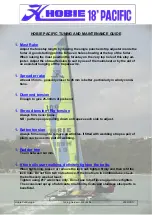
The jib is held furled by a snap hook
that is attached to the jib clew.
Before releasing the snap hook, spin
the jib clockwise 2 or 3 turns to start
spooling the furler line onto the furler
spool. Release the hook from the
loop and attach the 2 jib clew blocks
to the snap hook. The jib can now
be unfurled by pulling on the jib clew or tightening one side of
the jib sheets. This action will automatically roll the furling line
onto the furler spool as the jib un-furls.
(If the jib is not furled
and the line is also not loaded in the drum, wrap the jib
around the forestay until it is furled. Then when you
unfurl, it will load the drum as desired.)
To furl the jib, ease off on the
mainsheet tension and release
the jib sheets, pull on the jib furler
line. Keep light tension on the jib
sheet as the sail is being furled to
get a nice tight wrap. Cleat the
furler line in the furler cleat to
keep the sail furled.
There is a luff adjustment line that is installed at the jib top
(head) and may need to be adjusted. While the mainsheet is
tensioned, and the forestay is taunt, there should be just
enough tension to smooth the sail and remove the horizontal
wrinkles at the luff. Too much tension can damage the sail or
pull the head or tack grommet out when under sailing loads.
To adjust the line you must tip the boat onto it’s side or drop
the mast down to access the tensioning line at the jib top.
If the boat is being put away for the day the snorkel should be
installed. To do so, unhook the jib clew blocks and snap the
hook onto the loop sewn into the sail. This will keep the sail
tightly furled while the snorkel is installed. Re-attach the
zipper and slide the snorkel up the sail as it is zipped up.
The main halyard can be used to pull the snorkel up over the
jib, but if the sail is tightly furled, the halyard will not be
required. Route the halyard under a shroud and hook to the
snorkel and hoist. Tie the halyard to the halyard cleat.
12
RIGGING THE JIB SAIL
Thread the jib sheet line starting from
the eye next to the starboard (right
side) swivel cleat. Pass the line
through the stainless eye and tie a
figure 8 knot. Thread the onthe end
through one of the jib clew blocks and
then through the swivel cleat. Pass
the line through the swivel eye and
then the jaw and onto the main
trampoline. Cross over to the port (left) side and repeat the
process in reverse ending at the stainless eye with another
figure 8 knot.
The jib is furled on the forestay and
covered by a "snorkel". To remove
the snorkel, simply unzip as it is pulled
down.
MAINSHEET SYSTEM
Connect the main sheet block to the
traveler car. Attach the shackle that is
part of the block
through the clevis pin
on the traveler car.
Hook the mainsheet
to the "clew"
grommet at the rear
of the main sail.
The tail end of the main sheet line
is used for traveler adjustment.
Pass this line end through the
swivel cleat jaws (from forward
towards rear of the boat) then
eye. Pass the line through the
traveler car. Pass the line through
the stainless eye on the rear side of
the cross bar. Tie a figure 8 knot in
the end of the line to keep it from
coming out of the eye. When sailing
upwind, cleat the traveler more to
the center of the boat. On a reach
across the wind or when sailing
downwind adjust and cleat the
traveler further out the track. When
sailing in strong winds you can move the car further out to help
keep the boat more level and limit heeling or tipping.
Keep the mainsheets loose when the boat is on the beach to
prevent an accidental capsize.
Содержание Gateway
Страница 1: ...ASSEMBLY MANUAL ...






































